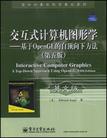交互式计算机图形学
2008-9
安吉尔 (Edward Angel) 电子工业出版社 (2008-09出版)
安吉尔
828
无
Tthis book is an introduction to computer graphics, with an emphasis on appli-cations vrogramming. In the first edition, which was published in 1997, I notedthat in the seven years since my previous graphics text, me nelo nan expenenceo enor-mous growthma rate of growth that exceeded most people's expectations, includingmy own. In the 11 years (and four editions) since, we have seen even more changes.Feature-length computer-animated movies have proved to be commercial and artis-tic successes. The use of computer effects in movies is standard, and it is often almostimpossible to distinguish live action from computer-generated effects. Recent hard-ware has blurred the distinction between computers and game boxes. Programmablegraphics processors provide a level of flexibility in commodity systems that was notavailable in even the most expensive workstations just a few years ago.Not only have graphics capabilities increased, but costs have been reduced forboth high- and low-end workstations. Within the last few years, the cost of a graph-ics system that can generate over 100 million three-dimensional polygons per secondwith lighting and texture mapping has gone from over $100,000 to less than $1000.The availability of commodity graphics boards for personal computers has been espe-cially significant. These boards provide support for sophisticated three-dimensionalapplications, starting at about $100. On the software side, OpenGL remains the stan-dard programmer's interface both for writing application programs and developinghigh-level products for muhiplatform applications. OpenGL supports applicationsranin from hrge scientific visualizations to cell phone games.A Top-Down ApproachThese recent advances and the success of the first four editions continue to reinforcemy belief in a top-down, programming-oriented approach to introductory computergraphics. Although many computer science and engineering departments now sup-port more than one course in the subject, most students will take only a single course.Such a course is placed in the curriculum after students have already studied pro-gramming, data structures, algorithms, software engineering, and basic mathematics.A class in computer graphics allows the instructor to build on these topics in a waythat can be both informative and fun. I want these students to be programming three-dimensional applications as soon as possible. Low-level algorithms, such as those thatdraw lines or fill polygons, can be dealt with later, after students are creating graphics.
覆盖了计算机图形学基础课程中的所有主题,包括光与材质的相互作用、明暗绘制、建模、曲线和曲面、反走样、光栅化、纹理映射和图像合成等内容。 在广泛结合OpenGL并注重图形应用编程的基础上,《交互式计算机图形学:基于OpenGL的自顶向下方法(第5版)(英文版)》向读者介绍了计算机图形学的核心概念。书中代码采用C和C++语言,并使用了自顶向下和面向编程的方法,使读者能够迅速地创建自己的三维图形。在结构安排上,《交互式计算机图形学:基于OpenGL的自顶向下方法(第5版)(英文版)》在读者学会了编写交互式图形程序之后再介绍底层的算法,如线段的绘制以及多边形填充等算法。
作者:(美国)安吉尔 (Edward Angel)
CHAPTER1 GRAPHICS SYSTEMS AND MODELS1.1 Applications of Computer Graphics1.1.1 Display of Information 1.1.2 Design1.1.3 Simulation and Animation 1.1.4 User Interfaces 1.2 A Graphics System1.2.1 Pixels and the Frame Buffer1.2.2 Output Devices 1.2.3 Input Devices 1.3 Images: Physical and Synthetic1.3.1 Objects and Viewers1.3.2 Light and Images 1.3.3 Image Formation Models1.4 Imaging Systems1.4.1 The Pinhole Camera 1.4.2 The Human Visual System 1.5 The Synthetic-Camera Model1.6 The Programmer's Interface1.6.1 The Pen-Plotter Model 1.6.2 Three-Dimensional APIs 1.6.3 A Sequence of Images 1.6.4 The Modeling-Rendering Paradigm 1.7 Graphics Architectures1.7.1 Display Processors 1.7.2 Pipeline Architectures 1.7.3 The Graphics Pipeline 1.7.4 Vertex Processing 1.7.5 Clipping and Primitive Assembly1.7.6 Rasterization 1.7.7 Fragment Processing1.8 Programmable Pipelines1.9 Performance CharacteristicsSummary and NotesSuggested ReadingsExercises CHAPTER2 GRAPHICS PROGRAMMING2.1 The Sierpinski Gasket2.2 Programming Two-Dimensional Applications2.2.1 Coordinate Systems2.3 The OpenGL API2.3.1 Graphics Functions 2.3.2 The Graphics Pipeline and State Machines2.3.3 The OpenGL Interface 2.4 Primitives and Attributes2.4.1 Polygon Basics 2.4.2 Polygon Types in OpenGL2,4.3 Approximatin9 a Sphere 2.4.4 Text2.4.5 Curved Objects2.4.6 Attributes 2.5 Color2.5.1 RGB Color 2.5.2 Indexed Color 2.5.3 Setting of Color Attributes 2.6 Viewing2.6.1 The Orthographic View 2.6.2 Two-Dimensional Viewing 2.6.3 Matrix Modes 2.7 Control Functions2.7.1 Interaction with the Window System2.7.2 Aspect Ratio and Viewports 2.7.3 The main, display, and myinit Functions 2.7.4 Program Structure 2.8 The Gasket Program2.9 Polygons and Recursion 2.10 The Three.Dimensional Gasket2.1O.1 Use of Three Dimensional Points2.10.2 Use Of Polygons in Three Dimensions 2.10.3 Hidden-Surface Removal 2.11 Plotting Implicit Functions2.11.1 Marching Squares Summary and Notes Suggested Readings Exercises CHAPTER3 INPUT AND INTERACTION3.1 Interaction3.2 Input Devices3.2.1 Physical Input Devices 3.2.2 Logical Devices 3.2 3 Input Modes 3.3 Clients and Servers3.4 Display Lists3.4.1 Definition and Execution of Display Lists 3.4.2 Text and Display Lists3.4.3 Fonts in GLUT 3.5 Display Lists and Modeling3.6 Programming Event Driven Input3.6.1 Using the Pointing Device3.6.2 Window Events 3.6.3 Keyboard Events 3.6.4 The Display and Idle Callbacks 3.6.S Window Management 3.7 Menus3.8 Picking3.8.1 Picking and Selection Mode 3.9 A Simple CAD Program3.10 Building Interactive Models3.11 Animating Interactive Programs3.11.1 The Rotating Square3.11.2 Double Buffering 3.11.3 Using a Timer 3.12 Design of Interactive Programs3.12.1 Toolkits.Widgets.and the Frame Buffer3.13 Logic Operations3.13.1 Drawing Erasable Lines 3.13.2 XOR and Color 3.13.3 Cursors and Overlay Planes Summary and Notes Suggested Readings Exercises CHAPTER4 GEOMTRIC OBJECTS AND TRANSFORMATIONS 4.1 Scalars,Points.and Vectors4.1.1 Geometric Objects 4.1.2 Coordinate.Free Geometry 4.1.3 The Mathematical View:Vector and Affine Spaces4.1.4 The Computer Science View 4.1.5 GeometricADTs 4.1.6 Lines 4.1.7 Affjne Sums 4.1.8 Convexity 4.1.9 Dot and Cross Products4.2 Three-DimensionaI Primitives4.3 Coordinate Systems and Frames4.3.1 Representations and N.Tuples4.3.2 Change of Coordinate Systems 4.3.3 Example Change of Representation4.3.4 Homogeneous Coordinates 4.3.5 Example Change in Frames 4.3.6 Working with Representations 4.4 Frames in 0penGL4.5 Modeling a Colored Cube4.5.1 Modeling the Faces 4.5.2 Inward-and Outward.Pointing Faces 4.5.3 Data Structures for Object Representation4.5.4 The Color Cube 4.5.5 Bilinear Interpolation4.5.6 Vertex Arrays4.6 Affine Transformations4.7 Translation,Rotation-and Scaling4.7.1 Translation 4.7.2 RotationCHAPTER 5 VIEWINGCHAPTER 6 LIGHTING AND SHADINGCHAPTER 7 FROM VERTICES TO FRAGMENTSCHAPTER 8 DISCRETE TECHNIQUESCHAPTER 9 PROGRAMMABLE SHADERS
插图:
《交互式计算机图形学:基于OpenGL的自顶向下方法(第5版)(英文版)》可作为计算机及相关专业本科生和研究生的计算机图形学教材,也适合作为相关程序员、工程技术人员及科研人员的参考书。

无
这本书确实深入浅出,但对于不是做图形学方向的人来说,实在是太辛苦了!里面的术语之类的,让我这个计算机专业的人看起来都非常头疼哦!但是书的内容只要硬头皮干下去了,绝对受益匪浅!
在没有大量编程经验的情况下,只靠目前市面上的书有些困难,不过从这本书里,还是可以了解OpenGL的功能与内容。OpenGL的学习要一定的编程基础,另外就是多看程序,不懂得地方查书,这也就是这本书的妙用了!
感觉发给我的书有点旧,不过不是用过的那种旧,感觉像是在压在仓库里的最后一本一样
纸张不行,其他还可以,内容本来就不错
印刷质量太差了,浪费一本好书。唉!书内容还是很好的